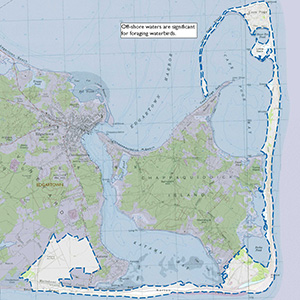Important Bird Area: Chappaquidick Island
Site Summary
Nominated By
Debra Swanson
Size
1,328 acres
Towns and Counties
Edgartown; Dukes
Ownership
Dukes County, private, The Trustees Of Reservation, The Nature Conservancy
Major Habitats
pitch pine/scrub oak, maritime heathland, early successional shrubland, emergent freshwater wetland, salt marsh, coastal beach, marine/tidal, lake/pond
Land Use
nature conservation, fishing/hunting, recreation/tourism
Serious Threats
introduced animals, succession, predators, disturbance, recreational use
Minor Threats
invasive/non-native plants
IBA Criteria
- Category 2: Sites containing assemblages of species characteristic of a representative, rare, threatened, or unique habitat within the state or region.
- Category 4: Shorebirds: The site regularly supports 1,000 or more shorebirds at one time at a coastal site, during some part of the year, or a significant concentration of shorebirds at one time at a nontidal site. The designation "shorebirds" includes birds such as plovers, sandpipers, snipe, woodcocks, and phalaropes.
Site Description
This IBA includes Cape Poge, Wasque, Norton Point Beach, and Katama.
Located on Chappaquiddick Island and habitat to the east, the site is dominated by sandplain grassland, maritime heathland, maritime shrubland, and a variety of coastal beaches, salt marsh, and tidelands. It is bordered to the east and south by approximately 12 miles of barrier beach and dunes, along with associated salt marsh, salt and freshwater ponds and bay, and 150 acres of farmland.
Current Conservation Status
Mixed ownership, some owned by Trustees of Reservations and The Nature Conservancy; some areas, especially heathlands, are seriously threatened by non-native plants, succession, and introduced predators.
Ornithological Significance
State and federally listed species: Piping Plovers - at least 12 pairs regularly breeding; Least Terns - up to 500 breeding pairs; Northern Harriers - at least 3 breeding pairs/nests.
American Oystercatchers - 12-15 breeding pairs; Willets - a few breeding pairs, but not confirmed.
Least, Common, and Roseate terns - over 300 present during migration seasons.
Black-crowned Night-Heron heronry, formerly large and included Snowy Egrets.
More than 500 marsh and sea ducks; Canada geese in bays during nonbreeding season.
At least 1,000 shorebirds during migration (including Sanderlings, Semipalmated Plovers, Black-bellied Plovers, Short-billed Dowitchers, Least Sandpipers, Semi-palmated Sandpipers, Dunlins, Ruddy Turnstones, Piping Plovers, Willets, etc.)
Unique and rare habitats: coastal beach/dune; maritime heathland/sandplain grassland, maritime Red Cedar forest.
Other Flora or Fauna of Significance
None listed.
Data Sources
Terns, Plovers, Oystercatchers: Annual Field Reports to Sheriff's Meadow Foundation, 1993-2002, by Debra L. Swanson
Northern Harriers: Personal observations
Field Reports by Dr. Rhys Bowen (1999 to Sheriff's Meadow Foundation; 2001 to The Nature Conservancy)




